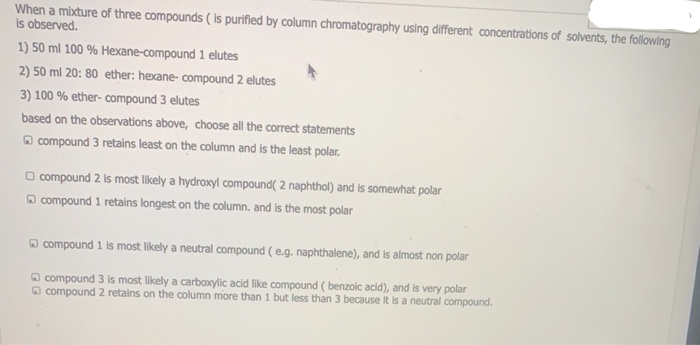When a mixture of three compounds ( is purified by column chromatography using different concentrations of solvents, the following is observed. 1) 50 ml 100 % Hexane-compound 1 elutes 2) 50 ml 20: 80 ether: hexane- compound 2 elutes 3) 100 % ether- compound 3 elutes based on the observations above, choose all the correct statements O compound 3 retains least on the column and is the least polar. O compound 2 is most likely a hydroxyl compound( 2 naphthol) and is somewhat polar O compound 1 retains longest on the column. and is the most polar O compound 1 is most likely a neutral compound (e.g. naphthalene), and is almost non polar O compound 3 is most likely a carboxylic acid like compound ( benzoic acid), and is very polar O compound 2 retains on the column more than 1 but less than 3 because it is a neutral compound.
When a mixture of three compounds ( is purified by column chromatography using different concentrations of solvents, the following is observed. 1) 50 ml 100 % Hexane-compound 1 elutes 2) 50 ml 20: 80 ether: hexane- compound 2 elutes 3) 100 % ether- compound 3 elutes based on the observations above, choose all the correct statements O compound 3 retains least on the column and is the least polar. O compound 2 is most likely a hydroxyl compound( 2 naphthol) and is somewhat polar O compound 1 retains longest on the column. and is the most polar O compound 1 is most likely a neutral compound (e.g. naphthalene), and is almost non polar O compound 3 is most likely a carboxylic acid like compound ( benzoic acid), and is very polar O compound 2 retains on the column more than 1 but less than 3 because it is a neutral compound.
Chapter91: Gas Chromatography
Section: Chapter Questions
Problem 1P
Related questions
Question
100%

Transcribed Image Text:When a mixture of three compounds ( is purified by column chromatography using different concentrations of solvents, the following
is observed.
1) 50 ml 100 % Hexane-compound 1 elutes
2) 50 ml 20: 80 ether: hexane- compound 2 elutes
3) 100 % ether- compound 3 elutes
based on the observations above, choose all the correct statements
O compound 3 retains least on the column and is the least polar.
O compound 2 is most likely a hydroxyl compound( 2 naphthol) and is somewhat polar
O compound 1 retains longest on the column. and is the most polar
O compound 1 is most likely a neutral compound (e.g. naphthalene), and is almost non polar
O compound 3 is most likely a carboxylic acid like compound ( benzoic acid), and is very polar
O compound 2 retains on the column more than 1 but less than 3 because it is a neutral compound.
Expert Solution
This question has been solved!
Explore an expertly crafted, step-by-step solution for a thorough understanding of key concepts.
This is a popular solution!
Trending now
This is a popular solution!
Step by step
Solved in 2 steps

Knowledge Booster
Learn more about
Need a deep-dive on the concept behind this application? Look no further. Learn more about this topic, chemistry and related others by exploring similar questions and additional content below.Recommended textbooks for you

EBK A SMALL SCALE APPROACH TO ORGANIC L
Chemistry
ISBN:
9781305446021
Author:
Lampman
Publisher:
CENGAGE LEARNING - CONSIGNMENT



EBK A SMALL SCALE APPROACH TO ORGANIC L
Chemistry
ISBN:
9781305446021
Author:
Lampman
Publisher:
CENGAGE LEARNING - CONSIGNMENT



Principles of Instrumental Analysis
Chemistry
ISBN:
9781305577213
Author:
Douglas A. Skoog, F. James Holler, Stanley R. Crouch
Publisher:
Cengage Learning